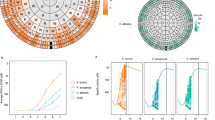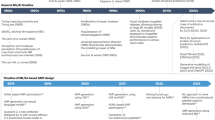Abstract
Antimicrobial peptides (AmPs) are small proteins that are used by the innate immune system to combat bacterial infection in multicellular eukaryotes1. There is mounting evidence that these peptides are less susceptible to bacterial resistance than traditional antibiotics and could form the basis for a new class of therapeutic agents2. Here we report the rational design of new AmPs that show limited homology to naturally occurring proteins but have strong bacteriostatic activity against several species of bacteria, including Staphylococcus aureus and Bacillus anthracis. These peptides were designed using a linguistic model of natural AmPs: we treated the amino-acid sequences of natural AmPs as a formal language and built a set of regular grammars to describe this language. We used this set of grammars to create new, unnatural AmP sequences. Our peptides conform to the formal syntax of natural antimicrobial peptides but populate a previously unexplored region of protein sequence space.
This is a preview of subscription content, access via your institution
Access options
Subscribe to this journal
Receive 51 print issues and online access
$199.00 per year
only $3.90 per issue
Buy this article
- Purchase on Springer Link
- Instant access to full article PDF
Prices may be subject to local taxes which are calculated during checkout

Similar content being viewed by others
References
Zasloff, M. Antimicrobial peptides of multicellular organisms. Nature 415, 389–395 (2002)
Hancock, R. E. & Patrzykat, A. Clinical development of cationic antimicrobial peptides: from natural to novel antibiotics. Curr. Drug Targets Infect. Disord. 2, 79–83 (2002)
Tiozzo, E., Rocco, G., Tossi, A. & Romeo, D. Wide-spectrum antibiotic activity of synthetic, amphipathic peptides. Biochem. Biophys. Res. Commun. 249, 202–206 (1998)
Biragyn, A. et al. Toll-like receptor 4-dependent activation of dendritic cells by β-defensin 2. Science 298, 1025–1029 (2002)
Ellerby, H. M. et al. Anti-cancer activity of targeted pro-apoptotic peptides. Nature Med. 5, 1032–1038 (1999)
Giangaspero, A., Sandri, L. & Tossi, A. Amphipathic α helical antimicrobial peptides. Eur. J. Biochem. 268, 5589–5600 (2001)
Shai, Y. Mode of action of membrane active antimicrobial peptides. Biopolymers 66, 236–248 (2002)
Jurafsky, D. & Martin, J. H. Speech and Language Processing: An Introduction to Natural Language Processing, Computational Linguistics, and Speech Recognition (Prentice Hall, Upper Saddle River, New Jersey, 2000)
Searls, D. B. The language of genes. Nature 420, 211–217 (2002)
Hofmann, K., Bucher, P., Falquet, L. & Bairoch, A. The PROSITE database, its status in 1999. Nucleic Acids Res. 27, 215–219 (1999)
Rigoutsos, I. & Floratos, A. Combinatorial pattern discovery in biological sequences: The TEIRESIAS algorithm. Bioinformatics 14, 55–67 (1998)
Wang, Z. & Wang, G. APD: the Antimicrobial Peptide Database. Nucleic Acids Res. 32, D590–D592 (2004)
Bairoch, A. & Apweiler, R. The SWISS-PROT protein sequence database and its supplement TrEMBL in 2000. Nucleic Acids Res. 28, 45–48 (2000)
Wu, M. & Hancock, R. E. W. Interaction of the cyclic antimicrobial cationic peptide bactenecin with the outer and cytoplasmic membrane. J. Biol. Chem. 274, 29–35 (1999)
Tossi, A., Sandri, L. & Giangaspero, A. Amphipathic, α-helical antimicrobial peptides. Biopolymers 55, 4–30 (2000)
Bell, G. & Gouyon, P-H. Arming the enemy: the evolution of resistance to self-proteins. Microbiology 149, 1367–1375 (2003)
Hilpert, K., Volkmer-Engert, R., Walter, J. & Hancock, R. E. W. High-throughput generation of small antibacterial peptides with improved activity. Nature Biotechnol. 23, 1008–1012 (2005)
Li, W., Jaroszewski, L. & Godzik, A. Clustering of highly homologous sequences to reduce the size of large protein database. Bioinformatics 17, 282–283 (2001)
Maizel, J. V. & Lenk, R. P. Enhanced graphic matrix analysis of nucleic acid and protein sequences. Proc. Natl Acad. Sci. USA 78, 7665–7669 (1981)
Acknowledgements
The authors would like to thank M. Zasloff, K. D. Wittrup, R. Berwick, and G. Georgiou for valuable input on the draft manuscript, and J. Moxley for figure preparation. The authors gratefully acknowledge the support of the Singapore-MIT Alliance, the NIH, and the Fannie and John Hertz Foundation.
Author information
Authors and Affiliations
Corresponding author
Ethics declarations
Competing interests
Reprints and permissions information is available at www.nature.com/reprints. The authors declare no competing financial interests.
Supplementary information
Supplementary Notes
This file contains Supplementary Tables 1–3, Supplementary Figure 1 and Supplementary Methods (PDF 176 kb)
Rights and permissions
About this article
Cite this article
Loose, C., Jensen, K., Rigoutsos, I. et al. A linguistic model for the rational design of antimicrobial peptides. Nature 443, 867–869 (2006). https://doi.org/10.1038/nature05233
Received:
Accepted:
Issue Date:
DOI: https://doi.org/10.1038/nature05233
This article is cited by
-
Rational design of stapled antimicrobial peptides
Amino Acids (2023)
-
Accelerated antimicrobial discovery via deep generative models and molecular dynamics simulations
Nature Biomedical Engineering (2021)
-
Potent antitumor activity of a glutamyltransferase-derived peptide via an activation of oncosis pathway
Scientific Reports (2021)
-
Design of improved synthetic antifungal peptides with targeted variations in charge, hydrophobicity and chirality based on a correlation study between biological activity and primary structure of plant defensin γ-cores
Amino Acids (2021)
-
HAPPENN is a novel tool for hemolytic activity prediction for therapeutic peptides which employs neural networks
Scientific Reports (2020)
Comments
By submitting a comment you agree to abide by our Terms and Community Guidelines. If you find something abusive or that does not comply with our terms or guidelines please flag it as inappropriate.



